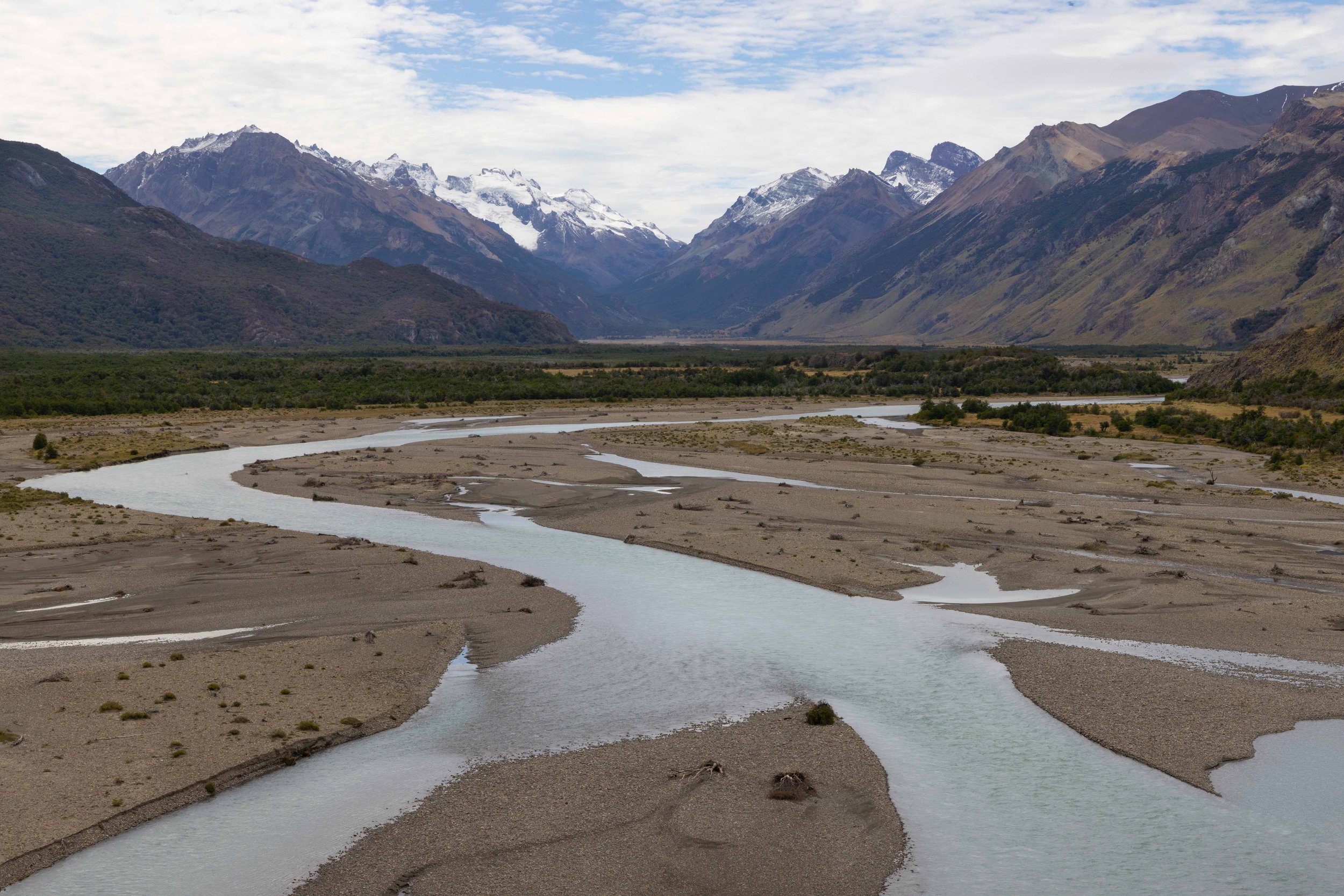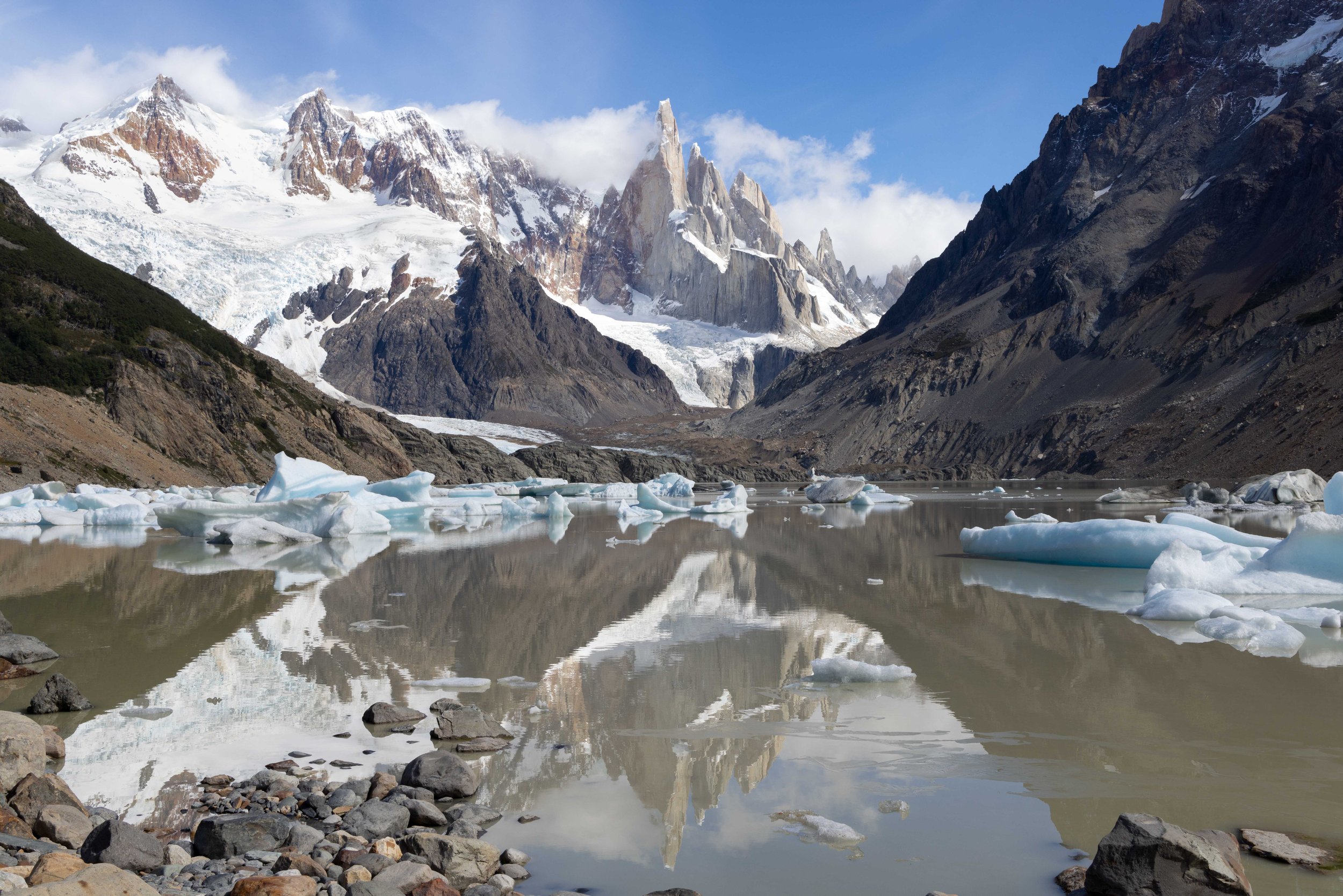In Patagonia, an untamed swath of mountains and ice
The south wall of Glaciar Perito Moreno loomed like an impermeable fortress of jagged ice as our boat chugged closer across Lago Argentino.
The glacier, an undulating sea of blue and white, snaked downhill toward the turquoise waters from distant, shrouded Andean peaks. Its face, weathered and ancient, was wrinkled and creased like old paper, gouged by the inexorable forces of pressure, gravity and time. It towered 200 feet over the lake’s surface, like a frozen tidal wave whose pointed fingers caressed the summer sky blanketing Patagonia.
Cracks and booms rang like gunshots as icebergs, some the size of apartment buildings, calved and exploded into the lake below with a thunderous roar. Shockwaves reverberated around the fjord, lapping at the glacier’s feet and appearing as little more than ripples against an edifice that extended three miles across to the northern shore.
The face of Glaciar Perito Moreno towers about 200 feet above the turquoise waters of Lago Argentino. The glacier, 30 kilometers long, is just one of hundreds in the Southern Patagonian Ice Field. ©Greg Iacurci
These frequent calving events and their close proximity to eager onlookers have made Perito Moreno perhaps the most famous of the ice sheets in Patagonia, a swath of wild, untamed land at the bottom tip of South America defined by its natural wonders.
You can feel that raw beauty in the vast windswept plains of yellow desert grass covering the Patagonian Steppe, where guanaco herds graze casually and Andean condors stalk silently overhead. It’s palpable in the rows of mountains that extend like the claws of great hands wreathed in snow, and in the gnarled, white limbs of dead trees, like fossils peppering vast forests and hillsides. It’s carried by the intermittent gales that hit like a punch in the face, flexing the boughs of dense Southern Beech stands, and inscribed in long, arcing rainbows fueled by weather patterns in a constant state of argument.
From top to bottom: Cerro Torre, one of Patagonia’s most famous peaks; a rainbow over Lago Nordenskjöld in Chile’s Parque Nacional Torres del Paine; the Cuernos mountains illuminated during sunset in Parque Nacional Torres del Paine. ©Greg Iacurci
Patagonia is a huge tract of land, encompassing some 400,000 square miles across Argentina and Chile. Sixteenth-century Spanish explorers are said to have described the native Tehuelches as “Patagones” (“big feet”), thereby bestowing the area with its name (“land of the big feet”).
In Patagonia’s south — where I traveled for two weeks in February, high summer in the Southern Hemisphere — the pristine landscape is interrupted only by lonely strips of two-lane road, the occasional rest house, and small towns like El Chaltén, El Calafate and Puerto Natales, the gateways to world-renowned national parks.
From top to bottom: A Patagonian fox stands by the roadside en route to El Chaltén, Argentina; a view of mountains and glacial melt during the trek to Laguna de los Tres in El Chaltén. ©Greg Iacurci
El Calafate is the portal to Perito Moreno, which rests in Parque Nacional Los Glaciares, a UNESCO World Heritage Site. The town, in Argentina’s southwest, derives its name from the eponymous berry that once eaten, legend holds, guarantees your return to Patagonia.
At 30 kilometers long, Perito Moreno is among the largest glaciers in Patagonia. It’s just one tongue of the Southern Patagonian Ice Field, a 13,000-square-kilometer ice sheet riding along the spine of the Andes between Argentina and Chile that, according to our guide, feeds about 860 different glaciers.
The Southern Patagonian Ice Field is the biggest contiguous ice mass in the Southern Hemisphere outside of Antarctica. It’s also melting at one of the fastest rates on earth. In this land of ice giants, Perito Moreno is an anomaly: The glacier is in a curious state of equilibrium, just one of two in the region that’s not receding. The other, Pío XI in Chile — also known as Brüggen Glacier, almost five times the area of Perito Moreno — is actually expanding.
As the glaciers roll back, Lago Argentino — a repository of meltwater and hulking, dazzling icebergs that break from Glaciar Upsala, Spegazzini and others — continually swells in volume. It’s the third largest lake in South America.
From top to bottom: A view of Glaciar Perito Moreno from a sightseeing boat; an iceberg floats in Lago Argentino after breaking from Glaciar Upsala; spires atop Glaciar Spegazzini; a second vantage point of the iceberg near Glaciar Upsala. ©Greg Iacurci
El Chaltén, the trekking capital of Argentina, ushers visitors into another landscape altogether, one of bold granite spires that stand like watchful sentinels draped in mist.
The bohemian enclave is the starting point for famed hikes like the one to Laguna de los Tres, an azure lagoon resting below the mighty feet of Cerro Fitz Roy. The peak, a crown jewel of Patagonia, thrusts skyward from the Andean range like a shark’s fin, juxtaposed by smaller granite daggers in the massif that stand like disciples bearing homage to their master.
Fitz Roy is also known as “Chaltén,” based on the native Aonikenk word for "smoking mountain,” its pinnacle almost perpetually enveloped by swirling clouds. Yvon Chouinard, founder of the outdoor clothing retailer Patagonia, chose a stylized silhouette of Cerro Fitz Roy and its brothers as his company’s logo.
Cerro Fitz Roy, also known as “Chaltén,” is almost always enveloped in cloud. Here, Fitz Roy is seen from the trail to Laguna de los Tres, one of two colorful lagoons resting at the mountain’s base. The second, Laguna Sucia, is pictured above. ©Greg Iacurci
The nearby Cerro Torre — another of El Chaltén’s celebrities — rises like a needle from the surrounding mountains, its head bowed and crowned with frost. On a clear, windless day, the behemoth’s liquid reflection is framed by icebergs that break free from Glaciar Grande and float lazily in the waters of Laguna Torre.
The Torre Group, part of the Southern Patagonian Ice Field, contains four distinct peaks. From left to right, they are: Cerro Torre (the largest), Torre Egger, Punta Herron and Cerro Stanhardt. Here, the mountains are seen from different vantage points along the trek to Laguna Torre. ©Greg Iacurci
It’s often said that visitors to Patagonia can experience four seasons in the course of a day. In Chile, heavy rain lashed us all morning while climbing Valle Ascencio toward the Torres del Paine, colossal granite towers that protrude from the earth like three upturned fingers and sit above the turquoise Lago Torres.
On the final ascent, rain clouds relented to warm sunshine, illuminating the spires, which materialized through the haze like a mirage. Minutes later, snow gently began to fall, and the towers disappeared again behind a thick, gray curtain. But therein lies part of Patagonia’s magic: Even a glimpse of its natural treasures is something to be celebrated, like a shooting star that burns brightly and quickly fades, but whose embers forever linger in memory.
The Torres del Paine in Chile. Volatile weather yielded just a short window of visibility when trekking to the towers’ base. The middle image here was taken the following morning, after the storm had faded. ©Greg Iacurci
Parque Nacional Torres del Paine is the site of the coveted W Trek, a roughly 50-mile route that ascends three different valleys in the Cordillera Paine range — hence giving the route its distinctive W shape. The hike meanders through roaring glacier-fed rivers, dense forest, rolling yellow grasslands of the pampas and snow-capped mountains, including Cerro Paine Grande (the massif’s dominant peak) and Los Cuernos (“horns” in Spanish), a grouping of crags with gray midriffs and brown tips that form a thorny blockade in front of the Paine towers.
From top to bottom: A gaucho in Parque Nacional Torres del Paine; porters playing music after a long day of hiking. ©Greg Iacurci
Beyond Patagonia’s iconic backdrops, there’s an unmistakable grandeur about its people: the big-hearted Chileans and Argentines whose pride for their homeland is outmatched only by their palpable zest for life.
While settling into a campsite in the shadow of the Cuernos, cheerful vocal and guitar melodies carried over the sounds of wind and cascading water. A group of porters, who each do the grueling work of carrying 90 pounds of hikers’ belongings from camp to camp, congregated by the dining hall and improvised Spanish songs over well-earned glasses of red wine and hand-rolled cigarettes. With gusto, a Canadian passerby yelled “Vamos Chile!” and the porters seized on the rallying cry, incorporating it into a vibrant, fluid call and response.
The anthem seemed to hang in the air, fusing with the gentle mist that had begun to fall, with the trees buffeting the hillsides that climbed toward soaring mountains, blanketed by clouds in the soft, fading light, and it was as if Patagonia itself had a voice, whispering of its own beautiful existence.
A waterfall below shrouded peaks of Los Cuernos in Parque Nacional Torres del Paine. ©Greg Iacurci
































